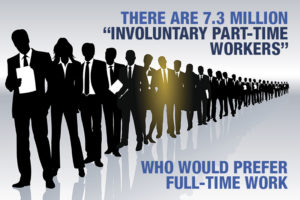How bad is underemployment?
The short answer is that no one really knows, but it is likely much worse than we think. Obviously, no politician wants to see employment numbers look worse, so there is no concerted effort to capture a truer picture of it in national labor statistics. Research by academics has found that there is likely a large number of underemployed people who are not counted—either because they do not qualify/apply for unemployment benefits or they attempt to cobble together a livelihood with freelance and contract work. If anything, the data that is released to the public likely underestimates the amount of underemployment hardship that actually exists. Underemployment is generally defined as one of four categories: (1) unemployment, or the most severe, which is what our statistics usually measure; (2) inadequate wages (the working poor); (3) involuntary part-time work; and (4) overeducation, or working in a job that does not require the individual’s highest skills, education and experience.
Inadequate wages. Although this does not constitute a standard measure of employment data, other measures have indicated that some 32% of SNAP (food stamp) recipients, 36% of TANF recipients (the new welfare-to-work program), and 61% of Medicaid recipients are working families. That is, they are working at jobs that do not pay subsistence wages and so we (the taxpayers) are subsidizing this.
Workers who are currently receiving public assistance do not include those who may not need help to survive right now, but are living on the edge of financial precarity. Recent estimates have found anywhere between 30 and 50% of Americans are only one unplanned emergency or one paycheck away from financial ruin, poverty or homelessness.
Involuntary part-time. The involuntary part-time rate is less than the official unemployment rate, but usually tracks it. That is, it rises during recessions and falls during recoveries. Although part-time work has been around for decades, it is usually associated with lifestyle choices such as a parent (usually the mother) raising children, a worker (also usually a woman) caring for an ill family member, or students accommodating class schedules. This measure became a concern, when the rate of involuntary part-time work virtually tripled between 1970 and 1990.

Over-education, or skills underemployment. This is the one form of underemployment for which there are no regular, recurring measures at the national level. Attention to this form of underemployment is cyclical. Early studies came out in the 1970s and early 1980s, as veterans returning from Vietnam on the GI bill and women began to graduate from college in record numbers. Attention was renewed again in a post-Great Recession economy, as there were stories everywhere about college graduates unable to find work and having to move back home. But there is obviously some data out there somewhere. In 2014, the Federal Reserve Bank of New York quietly released a study that found underemployment (conservatively defined as persons with college degrees working in jobs that do not require them) has remained at a fairly uniform rate of 33% over the past two decades.